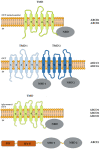The History of the ABC Proteins in Human Trypanosomiasis Pathogens
- PMID: 36145420
- PMCID: PMC9505544
- DOI: 10.3390/pathogens11090988
The History of the ABC Proteins in Human Trypanosomiasis Pathogens
Abstract
Human trypanosomiasis affects nearly eight million people worldwide, causing great economic and social impact, mainly in endemic areas. T. cruzi and T. brucei are protozoan parasites that present efficient mechanisms of immune system evasion, leading to disease chronification. Currently, there is no vaccine, and chemotherapy is effective only in the absence of severe clinical manifestations. Nevertheless, resistant phenotypes to chemotherapy have been described in protozoan parasites, associated with cross-resistance to other chemically unrelated drugs. Multidrug resistance is multifactorial, involving: (i) drug entry, (ii) activation, (iii) metabolism and (iv) efflux pathways. In this context, ABC transporters, initially discovered in resistant tumor cells, have drawn attention in protozoan parasites, owing to their ability to decrease drug accumulation, thus mitigating their toxic effects. The discovery of these transporters in the Trypanosomatidae family started in the 1990s; however, few members were described and functionally characterized. This review contains a brief history of the main ABC transporters involved in resistance that propelled their investigation in Trypanosoma species, the main efflux modulators, as well as ABC genes described in T. cruzi and T. brucei according to the nomenclature HUGO. We hope to convey the importance that ABC transporters play in parasite physiology and chemotherapy resistance.
Keywords: ABC transporters; T. brucei; T. cruzi; chagas disease; sleeping sickness.
Conflict of interest statement
The authors declare no conflict of interest.
Figures


Similar articles
-
Functional Characterization of ABCC Proteins from Trypanosoma cruzi and Their Involvement with Thiol Transport.Front Microbiol. 2018 Feb 14;9:205. doi: 10.3389/fmicb.2018.00205. eCollection 2018. Front Microbiol. 2018. PMID: 29491856 Free PMC article.
-
Rapid, Selection-Free, High-Efficiency Genome Editing in Protozoan Parasites Using CRISPR-Cas9 Ribonucleoproteins.mBio. 2017 Nov 7;8(6):e01788-17. doi: 10.1128/mBio.01788-17. mBio. 2017. PMID: 29114029 Free PMC article.
-
Diamidine activity against trypanosomes: the state of the art.Curr Mol Pharmacol. 2008 Jun;1(2):151-61. doi: 10.2174/1874467210801020151. Curr Mol Pharmacol. 2008. PMID: 20021429 Review.
-
The superfamily keeps growing: Identification in trypanosomatids of RibJ, the first riboflavin transporter family in protists.PLoS Negl Trop Dis. 2017 Apr 13;11(4):e0005513. doi: 10.1371/journal.pntd.0005513. eCollection 2017 Apr. PLoS Negl Trop Dis. 2017. PMID: 28406895 Free PMC article.
-
Sterol 14α-Demethylase from Trypanosomatidae Parasites as a Promising Target for Designing New Antiparasitic Agents.Curr Top Med Chem. 2021;21(21):1900-1921. doi: 10.2174/1568026621666210303144448. Curr Top Med Chem. 2021. PMID: 33655860 Review.
Cited by
-
Genomes of Endotrypanum monterogeii from Panama and Zelonia costaricensis from Brazil: Expansion of Multigene Families in Leishmaniinae Parasites That Are Close Relatives of Leishmania spp.Pathogens. 2023 Nov 30;12(12):1409. doi: 10.3390/pathogens12121409. Pathogens. 2023. PMID: 38133293 Free PMC article.
-
State-of-the-art Review on the Antiparasitic Activity of Benzimidazolebased Derivatives: Facing Malaria, Leishmaniasis, and Trypanosomiasis.Curr Med Chem. 2024;31(15):1955-1982. doi: 10.2174/0929867331666230915093928. Curr Med Chem. 2024. PMID: 37718524 Free PMC article. Review.
-
Expression Analysis of Thirteen Genes in Response to Nifurtimox and Benznidazole in Mexican Isolates of Trypanosoma cruzi by Digital PCR.Acta Parasitol. 2025 Jan 7;70(1):15. doi: 10.1007/s11686-024-00986-w. Acta Parasitol. 2025. PMID: 39775310
References
-
- WHO Research priorities for Chagas disease, human African trypanosomiasis and leishmaniasis. World Health Organ. Tech. Rep. Ser. 2012;975:1–100. - PubMed
-
- WHO . Investing to Overcome the Global Impact of Neglected Tropical Diseases: Third WHO Report on Neglected Diseases 2015. World Health Organization; Geneva, Switzerland: 2015. pp. 1–211.
Publication types
Grants and funding
LinkOut - more resources
Full Text Sources

